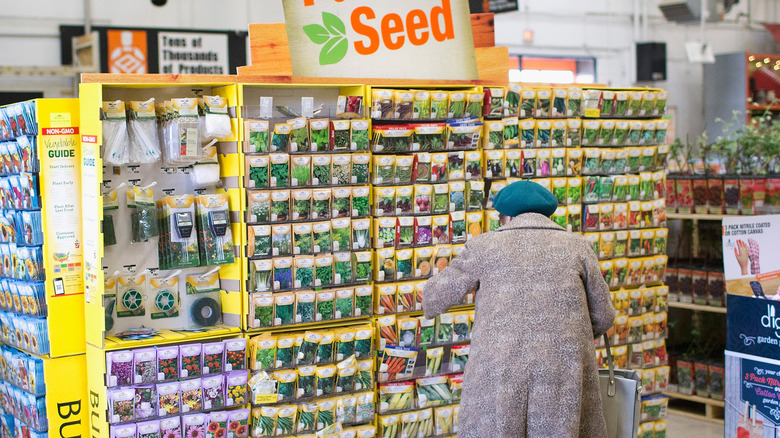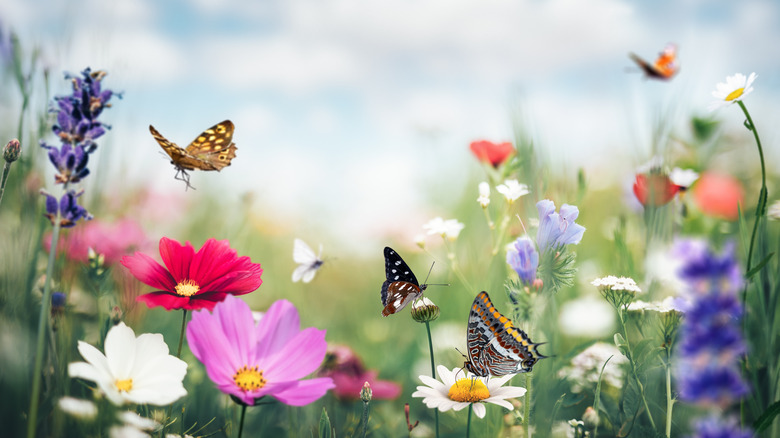TikTok Shares Why You Should Avoid Buying Seeds At A Big Box Store
The prospect of wildflower seeds is always exhilarating. For a small price, you can get hundreds of wildflower seeds and create a mini meadow in your yard. Dreams of laying in your wildflower garden and watching the at-risk pollinators come in droves start to flood your mind with peaceful and relaxing imagery. Well, one TikToker is here to burst that bubble. While some wildflower mixes can do a lot of good for the environment, they can also create some weedy problems.
First and foremost, TikToker @2Quacks5ClucksFarm explains how wildflower seed mixes from big box stores are a huge rip-off. They show us how these wildflower mixes come with 1.83% pure seed and 98.15% filler. While this may seem like a huge disparity in the ratios of wildflower seed to filler, this is not uncommon in mass-produced, big-box store wildflower seed packets. Additionally, the filler-to-seed ratio isn't the only problem with these seed packets. They are falsely advertised as native wildflowers when studies have shown that they are often not only not native but invasive weeds and flowers that can cause all sorts of problems for native wildlife. Don't despair, though. You can still grow wildflowers and attract all the beautiful butterflies and native pollinators to your yard — just don't get your seeds from big box stores!
Problems with wildflower seed packets from big box stores
As the above TikTok video illustrates, big box stores wildflower mixes are problematic, to say the least. When you pay $10 for a big bag of wildflower mix and only get 1% wildflower seed and 98% filler, it is not only disappointing but also ineffective. Additionally, if the seed mix is not used immediately or stored for too long, the filler can absorb moisture out of the seeds, which leads to a lower germination rate and seed viability. Essentially, when you buy wildflower seed mixes from big box stores, you're paying for filler and just a few seeds that may or may not germinate.
Furthermore, aside from issues with fillers and seed viability, most wildflower seed mixes come with non-native wildflowers or, worse, invasive weeds. Additionally, even if some of the wildflower species are native to some parts of North America, if they're not native to your specific bioregion, they will serve little to no benefit in the native ecosystem. Our at-risk pollinators, like our native bee species (not the honeybee, which is native to Europe and Africa), have specific and highly intelligent, intricate relationships with the native plants in their bioregion that they have evolved alongside for millennia. If you use a wildflower mix that has California poppies and you live in Georgia, not only will the plant be unhappy, but it won't serve any ecological benefit to the native ecosystem.
Alternatives to big box store wildflower mixes
There are lots of alternatives to buying wildflower mixes from big box stores, and it starts with putting in a little extra effort and doing some research. A great place to start is by checking out the Pollinator Partnership Ecoregional Planting Guide, where you can simply put in your zip code and receive a plethora of resources on native plants and wildflowers. Another great resource is the Xerces Society Pollinator Conservation Resource Center, where you can click your bioregion and get resources like habitat assessments, native plant lists, and installation guidelines
One thing remains abundantly clear: steer clear of those misleading, ecosystem-harming, waste of money and resources big box store wildflower mixes. Instead, find a native plant nursery near you (the Xerces Society Native Plant Nursery and Seed Directory makes this very easy), and order some seeds or plant starts! Support a local small business like a native plant nursery and cultivate native plants to contribute to their conservation and protection. There are lots of colorful wildflowers you can grow in your garden. Just be sure to look up their scientific name and identify if they are native to your bioregion. Nothing is worse than a well-intentioned gardener inadvertently creating problems for biodiversity and the ecosystem they are seeking to uplift. With some education and planning, gardeners can successfully support biodiversity and conservation efforts in their home gardens.

